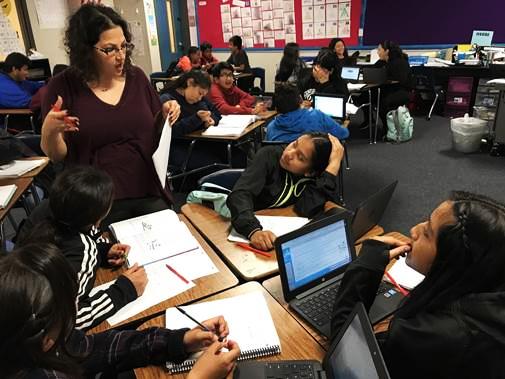Small changes can lead to big impacts. At Willard Intermediate school, small instructional shifts are underway in math classes, with the overall goal of improving outcomes for all students. Teacher Deborah Moure and her colleagues are investigating how small instructional changes are helping students collaborate and solve problems, and excitement for the improvement work is growing.
Willard Intermediate school is one of multiple schools participating in the CORE District’s Networked Improvement Community. The NIC is using improvement science to close the gaps in math for African American and Latino students, while improving performance for all students. Improvement science is helping schools such as Willard Intermediate analyze their current practice, generate ideas for change and try them quickly. Schools are fine-tuning changes along the way, using practical, classroom-level data to ensure that they are advancing toward their goals.
Daniel Allen, Santa Ana Unified School District’s assistant superintendent of K-12 teaching and learning, explained, “We not only are looking at math achievement data, but also at student social emotional learning.” Research shows that math outcomes are closely related to students’ growth mindset, students’ belief in their own abilities to solve problems and to persevere even when they make mistakes.
At Willard Intermediate, students’ math performance and growth mindset traditionally have been lower than the district average, according to Sharon Bi, SAUSD assistant director of research and evaluation. Last year, for example, less than 8 percent of Willard’s 8th grade students met or exceeded standards in math and fewer than half of Willard’s students reported a positive growth mindset.
The district’s efforts to improve student outcomes include adopting new math curriculum that emphasizes collaboration and group work. Willard Intermediate is the first SAUSD middle school to adopt these materials, a move prompted by the other two teachers on Willard’s math improvement team, Mark Petrie and Paul Zive.
“The willingness of our math teachers to learn together, be part of the improvement work in the district and have a designated math coach to help us is a triple win,” explained Scruton.
Moure, Petrie and Zive, with support from SAUSD’s math coach Jessica Salcedo, are implementing small changes, called plan-do-study-act cycles, to improve students’ group work and problem-solving. Teachers knew that students were having trouble getting started and engaging in the activity. They also knew they were not explicitly monitoring the group time, often distracted by individual questions and classroom management. One of their first change ideas was to try using a timer during classroom activity.
The change idea was to use a timer, to chunk tasks into specific minutes, clarifying how groups should approach the work, and to project the timer for everyone in the classroom to monitor. The team is documenting the changes and collecting data to see the effects. Teachers use a short student survey which records “time on task” and includes questions such as “Do you feel you helped someone in your group? Do you feel someone helped you?”
The results are helping teachers consider more deeply group work and its objectives. Teachers discovered that using the timer also helped them get around to each group and to provide support and assistance so students could collaborate more effectively to solve problems. Moure said, “Overall, we were able, more than ever before, to get through lessons with students regularly.”
Scruton says change is noticeable. “When I walk in these math classes, students are sitting in groups, they are discussing problems, they are working together to try to solve things, and there is the idea that there isn’t just one way to solve things. Students are encouraging one another to solve problems in various ways. Now students are validated in their thinking.”
“What has been really great about this work is we are proving that when you provide the right setting for your students, they can succeed,” said Scruton who was a math teacher before becoming an administrator. She took on the principalship at Willard three years ago with the goal of helping to address the math challenges. “Being a leader to help support teachers in their classrooms so students can succeed in math is exciting.”
Scruton said Moure’s enthusiasm for CORE’s improvement work is especially contagious. “When I talk to her, I walk away thinking ‘Wow, that is really awesome. She feels good about what she is doing and we are able to support her. Even If you start with one or two teachers that are really making a difference and running with it… that is how you start a movement.”
Willard Intermediate school serves 801 students in grades 6 through 8 in Santa Ana Unified School District. Ninety-eight percent of Willard’s students are Latino. 41 percent are English Learners, 99 percent are socio-economically disadvantaged and more than 30 percent are homeless.

